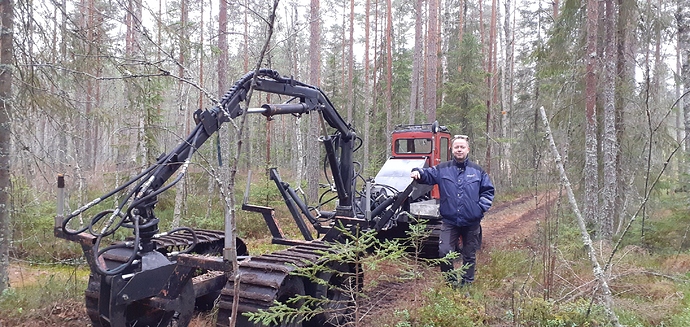Tom.
No, it’s called Iller bandvagn, they were made in Sweden, Forshaga, there were both private and military.
But be very low under, I have changed this a little.
Well, I would appreciate that very much, we are almost done with the moose hunt now, so maybe get some free some weekend.
I see you’ve been lucky hunting. Congratulations.
Oldest daughter hunts, but no moose for two weeks this year. She changed rifle and went for bird the other day, and guess what - the dog came chasing a moose calf and its mother. They passed on each side of the pine where she was sittning 
I’ll get back to you about the roadtrip.
I need to pour a lot of concrete for my project on my new land. I want to build with shipping containers and, need foundations. There are no transit-mixed companies on the coast of oregon near me. There are 2 big companies that have transit mixed as a part of their business. They charge about $600 a yard. I went looking on the net for ideas. Found this.
A friend just gave me a 700 gallon propane tank so, I have that covered. A couple years ago, I bought a nice Onan 2 cyl opposed engine just because it was a good deal. I’m in the process of looking for a hydraulic pump & motor. I also need flighting to make the mixing auger. A set of plans would be nice but, I don’t think that is going to happen. I build most things out of my head anyway.
My dad lived for those occasional moose hunts in
Canada!
That looks way overly complex and hard to clean to me. We had one of the simple old bin style mixers when I was a kid and we mixed a lot of cement for smaller jobs in it. Bigger jobs here it is actually cheaper to get it delivered by the yard per mixed in a truck.
https://www.harborfreight.com/3-1-2-half-cubic-ft-cement-mixer-67538.html
But something like this seems like it would give less trouble the only hard part is the pour but you get better with practice.
I can do up to 2 yards in a day in an old school mixer. It does a real good job. I would recommend using air entraining admixture for best results, makes a workable mix with less water, plus the obvious freeze protection…
WE are in climate change. Europe has lost 400,000 farms in the last year. The fires will get much worse. 2 years ago, oregon had 644 fires burning at the same time. I’m going to build using steel shipping containers. My 45 ft. high cube weighs over 10,000 lbs empty. I’m going to use four, 45 ft. high-cube containers for the house. The property is all clay. i need to pour a lot of cement to support all that weight.
The thing that I like about that particular mixer is; I can load it with my tractor. i’ve had 2 head-on crashes. One on the freeway. My shoulders are not in shape to shovel yards and yards of gravel and sand. I need to pour both slabs and footings. My entrance road has one section that is an 18% grade. Gravel tends to sink down into the clay and, need constant replacing. I want to concrete a small part of the road. I’d like to pour 1/2 yard minimum. Air entraining sounds like a good idea. I don’t have a big problem with freezing.
Hi William,
Concrete’s most strength is in compression. Concrete alone will not take
a lot of bending type load unless reinforced. Plain concrete, even three inches
thick will crack under car or truck weight on uneven or
stony ground. Crisscross 1/2" rebar, always overlapping 4 inches or more "
where the bars meet. STAGGER JOINTS! This will provide resistance to bending.
The size of the load will determine what size and how much rebar to use.
Your concrete dealer may be be able to help you with those numbers.
A half yard of concrete is NOT a lot. An 8’x8’x4" slab requires 21 cubic feet
(.8 of a cubic yard) of concrete (27 cubic feet is one cubic yard). A half yard
of concrete (13 cubic feet) doesn’t give much of a pad! Most dealers
have a minimum load charge, find out what it is. If you’re going to pay for
that minimum load, design to use it all, if you can. A thicker unreinforced
pad doesn’t necessarily provide the proper tensile strength for loads.
Remember, you only want to do this once and have it last forever. Not the
time or place to skimp. It will bite you in the ass in the end.
Oh, yeah, will this be on ground subject to frost heaves. That’s bending also,
so reinforcing is essential for longevity. Notice I said rebar, not welded wire mesh!
Ask if you have questions for me.
Good luck, Pepe
Reinforcement should always be placed at the midpoint of a slab too, otherwise it doesn’t have the same effect. “Bird cages” are preferred to bricks or stones for locating rebar, the solid objects can leave weak points in the slab. If a person is attentive, reinforcement can be pulled up to proper depth with a rake or by hand, but wire stands are the best approach.
Yes, the criss crossed rebar is under the entire slab, of course.
The rebar should be long full length single pieces, if possible, for
best strength.
The bird cage stands are great for support before the pour.
Overlaps should be about 2ft minimum, and preferably wire tied.
If it’s for foundations, I’d seriously consider using piles instead of concrete. Depending on the site, options are able to set with a long pipe/timber, bobcat/excavator. Price should be comparable or cheaper, especially if the site allows setting by hand, not equipment.
Knife River, the local big construction outfit charges about $500 a yard. My drive way has a section that is an 18% grade and, I don’t think they will go up it. I’ve always used rebar. I did my parents driveway in 2 pours. The second was 27 yards.
I can’t even bring in a heavy truck unless I put down many more tons of gravel. I already brought in twenty 10 wheeler loads just to do a small area and, the road.
Here are a couple of vids to give you an idea of what the property looks like. A friend who is doing the work is in the vids, not me. The first shows the Cat I bought and, how to start with a pony motor (engine)
The second vid is the road after MUCH grading.
Proper splice length for rebar is 40 times diameter
#4 bar would be 10”
It probably isnt as much as you think, if your soil down there is anything like the soil farther up in the willamette valley. I seem to recall that the silty loams we are on up here have a medium load capacity, like on the order of 2500 psf.
Looking at that chart, you could build a 1 story 8"thick walled cement building on 13" wide footings on that sort of soil - which I would think would be way more than enough for your high-cubes, even if you stacked them.
Although, if you are going to be using the floor inside the container, it probably makes more sense to just pour some pads at the corners and midpoints that are big enough to distribute the load. A 2’by 2’ pad should hold up 10,000 pounds. You could pour the slabs below grade on undisturbed soil, then just make concrete pilings that come up to the right level. Leveling paper form tubes is a lot easier than trying to level a bunch of independent slabs.
As for mixing up all the concrete for big slabs, that quickly gets tedious. I feel like I can do maybe 50sq ft of 4" slab, if i am working by myself. Thats a good size anyway, as it forces you to put in enough expansion joints.
Seems like a cool idea for a mixer, btw, send some pictures if you fab something like that up.
Thanks, Corey! That is the most promising H2 fuel cell news I have seen. 150+ mile range is very useful, I think! Kudos to Cummins.
Made a 110 mile DOW trip today to visit @Jan and to take a closer look at his Iller.
I gave Jan a woodgas ride around his neck of the woods and was invited for coffe and cake. It’s a real treat to have conversations with like-minded.
Thank you Ann-Kristin and Jan!
Oh, and to cover the travel expence I was even given a bag of chunks for my return trip 







